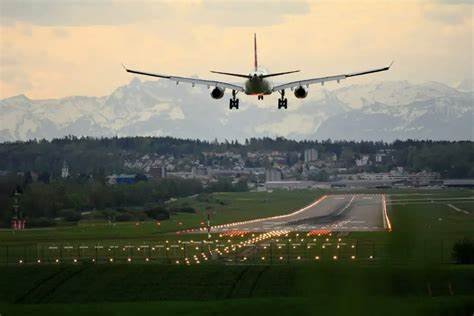The length of a runway plays a pivotal role in the safe and efficient operation of aircraft. Every aircraft has specific runway length requirements that are influenced by factors such as its size, weight, and type of operation. Whether it’s a small private plane or a large commercial airliner, understanding the relationship between runway length and aircraft performance is crucial for ensuring safety during takeoff and landing. In this article, we explore how runway length impacts different types of aircraft and what considerations must be taken into account when designing and selecting runways for specific aviation needs.
Small Aircraft and General Aviation: Shorter Runway Requirements
Small aircraft, including light planes and private jets, have relatively low takeoff and landing speed requirements compared to larger aircraft. As a result, they can operate on shorter runways, typically ranging from 1,000 to 3,000 feet, depending on the aircraft type and its specific performance capabilities. These aircraft tend to be lighter in weight, which allows them to take off and land within a smaller area, providing greater flexibility in terms of runway length.
For example, a single-engine propeller plane, such as a Cessna 172, requires approximately 1,600 feet of runway for takeoff under standard conditions. In contrast, a private jet like the Learjet 75 may require up to 5,000 feet of runway for a safe takeoff, depending on the weather and runway conditions. Smaller airports and airstrips are often designed with these aircraft in mind, offering shorter runways to accommodate general aviation operations.
Regional Aircraft: Moderate Runway Length Requirements
Regional aircraft, such as turboprops or small regional jets, typically have more weight and power than small general aviation aircraft, necessitating slightly longer runways for safe operations. These aircraft, which are often used for shorter regional routes, generally require runways between 3,000 and 5,000 feet. The additional length is needed to accommodate their higher speeds during takeoff and landing, as well as to provide enough distance for emergency situations.
For example, a regional turboprop like the ATR 72 requires around 3,000 to 4,000 feet of runway for takeoff, while a regional jet such as the Embraer E175 may require up to 5,000 feet. Airports serving regional flights are usually equipped with runways of this length, which are sufficient for the majority of aircraft operating within the regional airline sector.
Commercial Airliners: Long Runway Requirements
Large commercial airliners, such as the Boeing 737 or Airbus A320, have significantly higher takeoff and landing speeds due to their size, weight, and the number of passengers they carry. These aircraft require long runways, often ranging from 6,000 to 10,000 feet, depending on the specific model, weather conditions, and payload. The runway length is necessary to allow these aircraft to accelerate to takeoff speed and decelerate safely after landing, particularly when carrying a full load of passengers and cargo.
For instance, a fully loaded Boeing 737 may require around 8,000 feet of runway for takeoff, while the Airbus A380, one of the largest commercial airliners, requires up to 13,000 feet, especially in hot and high-altitude conditions. Airports that cater to commercial flights must ensure that their runways meet the minimum length requirements for such aircraft to maintain safe and efficient operations.

Discover Aviation Resources
Explore the resources and community for pilots and aviation enthusiasts at MAPilots.org. For those interested in exploring different forms of online entertainment, you can find information at https://www.gambling360.com/online-slots/.
Cargo Aircraft: Specialized Runway Lengths for Heavier Loads
Cargo aircraft, which often carry heavy and bulky goods, also require long runways due to their increased weight. Similar to commercial airliners, cargo planes such as the Boeing 747 Freighter or the Lockheed Martin C-130 Hercules require more distance to accelerate to takeoff speed and decelerate after landing. The runway length for cargo aircraft typically ranges between 7,000 and 12,000 feet, depending on the aircraft type and the weight of the load.
For example, the Boeing 747-400F, a freighter version of the popular passenger aircraft, requires a runway length of about 10,000 feet for safe operations under typical conditions. Larger cargo planes, particularly military transport aircraft or specialized freighters, may require even longer runways to accommodate their heavy payloads.
Military Aircraft: Varying Requirements Based on Role and Design
Military aircraft are designed for a wide range of roles, from tactical operations to long-range missions. As such, their runway requirements can vary significantly. Fighter jets, which are often designed for short takeoff and landing (STOL) capabilities, can operate on much shorter runways, typically between 2,000 and 5,000 feet. These aircraft are built for agility and speed, often using military airfields with shorter and more rugged runways.
On the other hand, larger transport aircraft, such as the Lockheed C-5M Super Galaxy, require much longer runways due to their size and cargo capabilities. These aircraft typically need runways of around 8,000 to 12,000 feet, depending on the weight of the load and the elevation of the airport. Military airfields must be designed to accommodate a variety of aircraft types, including both short takeoff and landing planes as well as long-range transport aircraft.
Factors Affecting Runway Length Requirements
Several factors influence the runway length needed for safe aircraft operations, regardless of the aircraft type. These include:
- Altitude: Airports located at higher elevations require longer runways, as the thinner air reduces engine performance and aircraft lift. Pilots need more distance to accelerate to takeoff speed and achieve sufficient lift.
- Weather Conditions: Hotter weather conditions can also increase the required runway length, as warm air is less dense, which reduces the aircraft’s ability to generate lift. Airports in hot climates may need longer runways to accommodate these factors.
- Aircraft Load: The weight of the aircraft, including passengers, cargo, and fuel, plays a significant role in determining the runway length. Heavier aircraft require more runway distance to take off and land safely.
- Runway Surface: The type of surface material, such as asphalt or concrete, can impact braking efficiency and aircraft acceleration. A well-maintained and smooth runway ensures better performance for aircraft of all sizes.
Conclusion: Tailoring Runway Length to Aircraft Needs
Runway length is a crucial consideration in ensuring safe and efficient operations for all types of aircraft. From small general aviation planes to large commercial airliners and cargo aircraft, each type of aircraft has specific runway requirements that must be met for successful takeoff and landing. Airports must take these requirements into account when designing and constructing runways, ensuring that they provide sufficient length to accommodate a variety of aircraft under different operational conditions. By understanding the relationship between runway length and aircraft performance, aviation authorities can ensure the safety of both passengers and crew members, as well as the efficient operation of the global aviation network.










